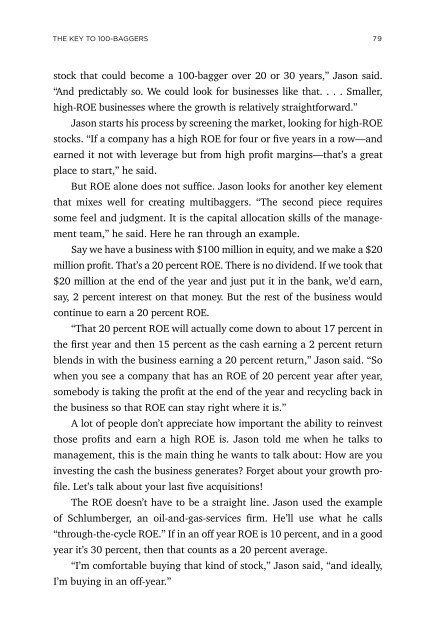You also want an ePaper? Increase the reach of your titles
YUMPU automatically turns print PDFs into web optimized ePapers that Google loves.
THE KEY TO 100-BAGGERS 79<br />
stock that could become a 100-bagger over 20 or 30 years,” Jason said.<br />
“And predictably so. We could look for businesses like that. . . . Smaller,<br />
high-ROE businesses where the growth is relatively straightforward.”<br />
Jason starts his process by screening the market, looking for high-ROE<br />
stocks. “If a company has a high ROE for four or five years in a row—and<br />
earned it not with leverage but from high profit margins—that’s a great<br />
place to start,” he said.<br />
But ROE alone does not suffice. Jason looks for another key element<br />
that mixes well for creating multibaggers. “The second piece requires<br />
some feel and judgment. It is the capital allocation skills of the management<br />
team,” he said. Here he ran through an example.<br />
Say we have a business with $100 million in equity, and we make a $20<br />
million profit. That’s a 20 percent ROE. There is no dividend. If we took that<br />
$20 million at the end of the year and just put it in the bank, we’d earn,<br />
say, 2 percent interest on that money. But the rest of the business would<br />
continue to earn a 20 percent ROE.<br />
“That 20 percent ROE will actually come down to about 17 percent in<br />
the first year and then 15 percent as the cash earning a 2 percent return<br />
blends in with the business earning a 20 percent return,” Jason said. “So<br />
when you see a company that has an ROE of 20 percent year after year,<br />
somebody is taking the profit at the end of the year and recycling back in<br />
the business so that ROE can stay right where it is.”<br />
A lot of people don’t appreciate how important the ability to reinvest<br />
those profits and earn a high ROE is. Jason told me when he talks to<br />
management, this is the main thing he wants to talk about: How are you<br />
investing the cash the business generates? Forget about your growth profile.<br />
Let’s talk about your last five acquisitions!<br />
The ROE doesn’t have to be a straight line. Jason used the example<br />
of Schlumberger, an oil-and-gas-services firm. He’ll use what he calls<br />
“through-the-cycle ROE.” If in an off year ROE is 10 percent, and in a good<br />
year it’s 30 percent, then that counts as a 20 percent average.<br />
“I’m comfortable buying that kind of stock,” Jason said, “and ideally,<br />
I’m buying in an off-year.”


